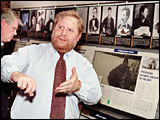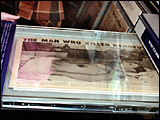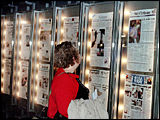MURDER AND MAYHEM AT THE NEWSEUM
5,000 Years of Crime Reporting
November 14, 1998
By Hoag Levins

|
|
Photo: Hoag Levins
Newseum managing editor Eric Newton explains famous crime exhibits.
|
|
ARLINGTON, Va. (APBnews.com) -- It was an evening of murder and mayhem at the Newseum as that unique institution hosted a special celebration of crime news reporting for more than three dozen members of the Criminal Justice Journalists (CJJ) association. The Newseum, best known as the nation's only museum dedicated to the profession of news gathering, normally treats its visitors to an entertaining look at the overall history of newspapers, radio, television and Internet news.
But last night, in a special production, Newseum managing editor Eric Newton led the CJJ reporters through a multidimensional tour of 5,000 years of criminal justice reporting.
Culling crime-news milestones from the museum's unique archives of news materials, Newton also provided an ongoing commentary. "The complaints about reporting have always been the same," he explained. "Inaccuracy, bias, sensationalism, invasion of privacy."
The first report: politician's illicit sex
The first stop on the tour was a clay tablet roughly the size of a shoe sole inscribed with what looked like rhythmic chicken scratches that were actually characters of the Sumerian language. According to Newton, that artifact says as much about the rise of civilization as about mankind's unquenchable desire to read the local dirt.
Excavated in what is now Iraq, the tablet is one of the earliest examples of human writing ever found -- as well as a news report. The message from 3100 B.C. reports that the mayor denied charges that he visited a local brothel.
Crossing several centuries, heading into the 1100 B.C. section, the group stopped at a delicate sheet of papyrus covered with letters made by an inked bit of sharpened reed. It is a report of a robbery at the tomb of the sons of Ramses the Great. The pharaoh sent four different reporters to the scene and had them dispatch their own independent accounts of what they found -- one of the first instances of a multiple-sourced crime story.

|
|
Photo: Hoag Levins
Preserved newspaper features morgue photo of Lee Harvey Oswald.
|
|
Dismemberment
Somewhere in the middle of Europe's Renaissance, Newton stopped to read aloud the headlines on the early "news books" that preceded newspapers as chronicles of current events. The lead stories were of murders, robberies, sexual molestations and assorted horrific crimes. One story's illustration showed a man involved in a Jeffery Dahmer-like mutilation, holding up parts of freshly dismembered bodies.
Tramping toward the nineteenth century, CJJ members encountered the penny papers, the first mass circulation newspapers, and the true beginnings of modern crime reporting. The carefully preserved pages indicate that James Gordon Bennett of the New York Herald was a titan of this era and a root to which CJJ can trace itself.
Establishing a whole new approach to crime writing in the 1830s, Bennett investigated the killing of a young prostitute named Ellen Jewitt. He inspected the house where she died, extensively interviewed her madam, co-workers and other people with information about the case.
Echoes of O.J.?
Bennett wrote and published a multi-part series that raised so many doubts about the police case against a suspect that the suspect was eventually freed and no legal determination was ever made about who killed the victim.
"Sound familiar?" asked Newton, a bear of a man given to elfish grins and expansive sweeps of the arm as he makes a point or underscores an irony.

|
|
Photo: Hoag Levins
Newseum visitors browse newspaper front pages from around the world.
|
|
Past more decades of blood-laced newsprint history, the tour stopped to gather around the display of the actual electric chair from Sing-Sing prison in which hundreds of people were put to death earlier this century. On the wall nearby was a giant enlargement of the 1928 New York News front page featuring a photo of Ruth Schneider strapped in the same chair at the instant of her death.
A newspaper photographer took the photo with a secret ankle camera. The impact of the image was so great that the newspaper sold more than 1 million extra copies and kept printing the same picture on its front page for three days in a row.
But don't stop now, Newton urged his visitors, gesturing toward the rest of the long gallery stretched out before them. There, the newspapers and front pages of LIFE magazine gave way to flickering TV screens until it all ended in a cul de sac hung with a massive digital screen displaying the smiling, cherubic face of JonBenet Ramsey.
"In every era of human history, you can find the best and the worst of a culture in its crime news," Newton told his guests. "Both choices have always been available, and as we move forward toward Matt Drudge and the Starr Report, we'll see that everything -- and nothing at all -- has changed in 5,000 years of crime news writing and crime news reading."
Hoag Levins is the managing editor of APBnews.com.
© 1998 APBnews.com
.
| 
